The Museum Collections
Introduction
I. History and Art Collection
1. Icons of the 14th – 19th centuries
icons of the 14th – 17th century
2. Jewelry art of the 14th – 20th century
jewelry art of the 14th – 17th century
jewelry art of the 18th – 19th century
the european silver 14th - 19th centuries
3. Small-size sculptures (works of metal, wood, bone)
XI – the beginning of the XX century
Small-size sculptures 11th – 17th century
Small-size sculptures 18th – early 20th century
enamel of Troitza masters 15-8th – early 20th century
5.Embroidery, lace, textiles of the 14th - early 20th century
icon and ornamental embroidery
gold and silver lace
6.Painting of the 18th – 21st centuries
painting of the 18th – 19th centuris
painting of the 20th – 21st centuris
II.Manuscripts and old printed books of the 14th – 17th century
IV.Lithography of the 18th – 19th century
V.Numismatics
VI.Medals of the 18th - early 20th century
VIII.Archeology collection
IX. Russian folk and applied and decorative art of the 17th – 21st c.
1. Artistic wood
folk carved and painted wood
wooden toys
house carving of Sergiev Posad
Khokhloma and Gorodets painting
2. Artistic textiles
embroidery and weaving
printed textiles and lace
Russian shawls
folk costumes
folk garments
printed cotton kerchiefs
|
Painting of the 18th – 19th century (p.3) |
In a museum collection, there are individual pictures and etudes of known Russian artists of the end 19th and the beginning of the 20th century. A pearl of the collection is I.K.Ayvazovskiy's picture "Surf" (Ill. 29). Created in last years of his creativity (on it there is an author's date "1895"), it testifies about coloristic gift of the outstanding marine painter, fantastic ability to transfer colour and lighting nuances of a sea smooth surface and sea air.
Among all etudes rise above the small etude, made by A.K.Savrasov in the 1880th (Ill. 30). On it represents the image of the artist’s favorite transitive condition of the nature - the beginning of spring. The landscape has differs simplicity of motive, which underlines its remarkable picturesque qualities. It colorist constructed on a combination of numerous shades of the grey, perfectly transferring friable melted snow, transparent spring air and a haze of clouds.
The emotional perception of the nature is typical for the small lyrical landscape «A pond in a patrimony of Trubetsky. Akhtirka», written by G.F.Jartsev (Ill. 31), in 1896. The follower of V.D.Polenov, an exhibitor of “Tovarischestva Peredvignih vistavok” (Association of Mobile exhibitions), G.F.Jartsev was the active representative of young generation of the artists, trying to update “peredvignichestvo” in the late of 80th - the beginning 90th of the 19th century.
In a museum collection, there is also a sketch of scenery "Novgorod" of Konstantin Korovin to opera «Sadko» by Russian composer N.A.Rimsky-Korsakov (Ill. 32). Being the universal master, who worked in the painting and the arts and crafts, K.Korovin was the magnificent decorator. He becomes famous for setting of performances of Russian Private Opera of S.I.Mamontov, and late he worked subsequently in the Bolshoi theatre, in Paris for S.Dyagilev. One of his sketches in our collection, possibly, made for performance of Bolshoi theatre.
|
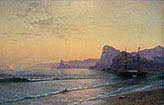
Ill. 29 |
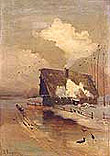
Ill. 30 |
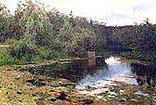
Ill. 31 |
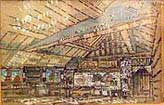
Ill. 32
|
|
In the beginning of the 20th century, the image of Sergiev Posad has appeared in art of one of coryphaeus’s of a Russian landscape - K.F.Yuon (1875-1958). Sergiev Posad was an embodiment of an aesthetic ideal of the artist, who has named our city «the world of fantastic beauty», «a national pearl». In a collection of our museum are two Troitsk watercolors of Yuon: « View of the Monastery from Station street» 1911 (Ill. 33)and «The Assumption cathedral of the Trinity-St. Sergius Lavra » 1920 (Ill. 34) – typical for the artist architectural landscapes with genre scenes, with inherent to them unity of the nature, ancient architecture and people.
|
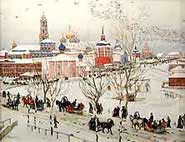
Ill. 33 |
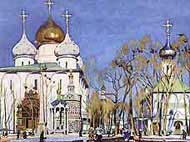
Ill. 34
|
Picturesque collection of the 18-19th centuries represents the small, but enough full complex of the works, necessary for understanding of difficult ways of development of Russian art. Many of them - works of unknown or little-known artists, whose creativity makes that background, on which there could be outstanding masters. Works of I.Nikitin, A.Antropov, F.Matveev, I.Ayvazovsky, A.Savrasov, K.Yuon strengthen the value of our collection.
|
|


